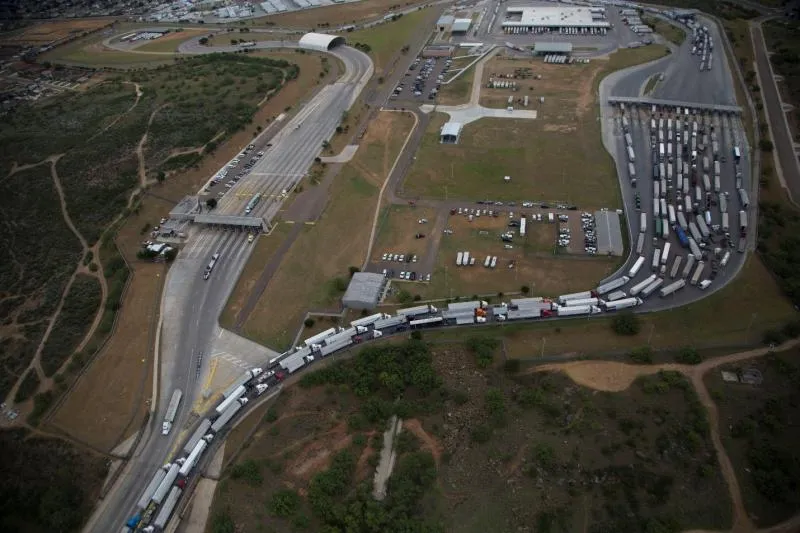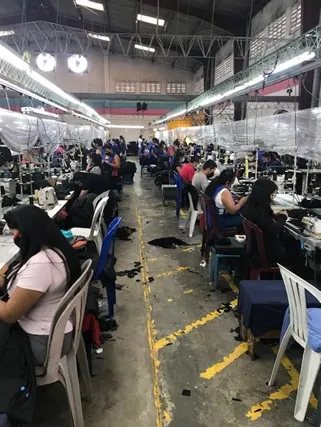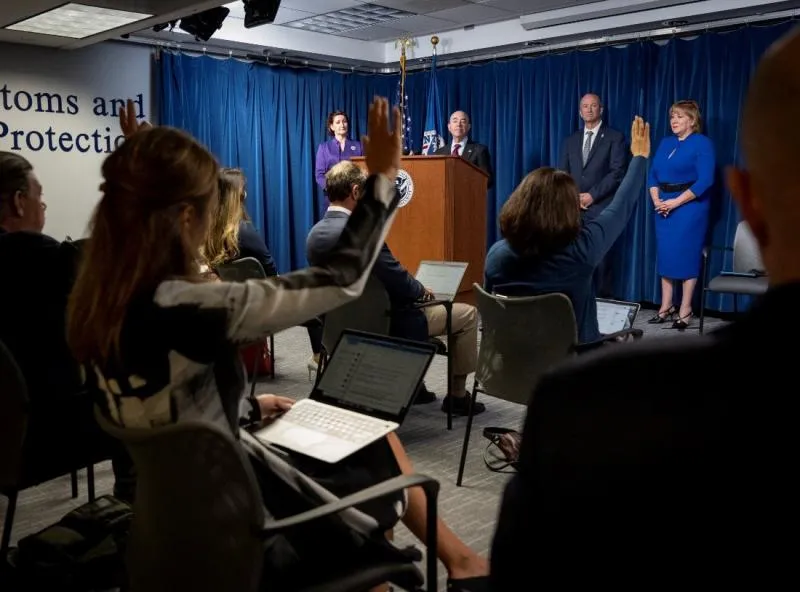
Behind the Scenes of America’s Free Trade Agreements
Graphic by Janice Jones
Trillions of dollars in international imports flow each year through 328 ports of entry like major arterial networks connecting producer, to importer, to consumer in a constant and cyclical circulation of goods and revenue. It is the lifeblood of the American economy, supporting U.S. industry and businesses to keep America’s economic heartbeat strong and steady. They arrive in every form imaginable – electronics, clothing, pharmaceuticals, furniture, cars and more. Sometimes they arrive ready to sell, and sometimes they represent the raw materials or parts required for further production like metals, timber and textiles.

inbound to the U.S. from Mexico. Photo by Donna
Burton
Thousands of trade specialists and personnel at U.S. Customs and Border Protection work tirelessly to facilitate this cycle so U.S. businesses and stores of every kind have access to merchandise from around the world to stock their shelves and consumers can choose from a variety of wares whether browsing online, at the mall, in supermarket aisles or at the local car dealership. Choosing products based on origin, price point, personal values and quality are all part of the American shopping experience. But how do Canadian blueberries make it into our local grocery, thousands of miles away, at such an affordable cost despite the labor, shipping and duties associated with their migration from one country to another?
Our freedom to pick and choose between our favorite clothing brands, sustainable goods, tropical produce and cars is due in part to 15 U.S. free trade agreements. These agreements create the regulatory and legal frameworks that make it possible for countries around the world to exchange goods with the U.S. in ways that prove mutually beneficial to importers, exporters and consumers. Behind each trade agreement is a team of CBP experts who inspect incoming packages and review scheduled shipments to make sure that American buyers have access to what they want, when they want it, so American industry has access to buyers and sellers in the international market.
“We are a high consumer society,” explained Maya Kamar, director of the Textiles and Trade Agreements Division in CBP’s Office of Trade. “Free trade agreements facilitate access to international markets for both consumers and businesses. This creates greater variety for the consumer, while ensuring greater market access for American businesses who wish to sell their goods outside of the United States,” she said. “Without free trade agreements, which is 25% of all the merchandise that is being imported into the United States, the choices would be more limited.”
Choice, in this context, doesn’t just mean choosing between one brand or another. It means having transparency into how a good was produced so that consumers can decide whether or not to support specific products based on their priorities and values, such as environmental sustainability or humane labor conditions.
CBP personnel are responsible for ensuring the trillions of dollars of goods that enter the U.S. meet the health, safety, environmental and legal requirements of the U.S. government. There is a CBP employee who worked behind the scenes to get every imported automobile safely into your driveway.
For Kamar and team, this means long hours supporting the U.S. Trade Representative in negotiations with foreign counterparts to iron out details of the implementation of new and existing agreements across multiple time zones.
“We’re meeting with Korea Wednesday,” she said. “The meeting is from 6:30 p.m. to 7:30 p.m. because that works with their time zone. When we meet with Singapore, we take turns. Sometimes it’s early in the morning for us, sometimes it’s late at night. The world doesn’t stop just because it’s closed here.”
Kamar’s team also travels to manufacturing sites around the world to verify origin and production of U.S.-bound goods to ensure they comply with U.S. trade laws. The team collaborates with U.S. Immigration and Customs Enforcement’s Homeland Security Investigations to complete upward of 200 unannounced site visits each year targeting factories based on an evaluation of risk. Kamar’s team coordinated with CBP attachés located in 23 countries during the COVID-19 pandemic to ensure these impromptu visits continued despite pandemic-imposed travel restrictions.

manufacturer in Guatemala. Photo by Manuel Levario
Implementing the U.S.-Mexico-Canada Agreement
For Queena Fan, Daniel Treadway and Adam Sulewski, members of CBP’s United States-Mexico-Canada Agreement Center, keeping legitimate trade flowing meant conducting outreach sessions for thousands of industry representatives in 2020 to prepare them for the shift from the second oldest trade agreement in U.S. history, the North American Free Trade Agreement, to the newest – a herculean effort that required extensive collaboration and teamwork across U.S., Mexican and Canadian governments. Fan, Treadway, Sulewski and a team of CBP trade specialists raced against time in the midst of a global pandemic and under the bright, sometimes burning, international spotlight to ensure the historic shift to USMCA was as uneventful for the average consumer as possible.
“When I first got here, I was like a deer in headlights because everything moves so fast. I saw the production from the rest of the team and wanted to contribute as they did. The team’s level of effort makes an immediate impact,” said Treadway, an auditor supporting CBP’s USMCA Center. “There are so many people counting on you, and it’s an area that has a huge spotlight on it, and you want to be held accountable.”
CBP’s efforts to prepare the trade community for the transition to USMCA were fast and furious. Personnel from across the agency lent a hand to ensure the various moving parts fell into place by July 1, 2020.
“We still had to make things happen, COVID or not,” said Fan, director of the USMCA Center. “Trade is always going to move.”
While CBP’s team ramped into high gear as they transitioned the agency and the nation from NAFTA to USMCA, for many Americans USMCA simply became a quiet backdrop of our daily lives, overshadowed by the more dramatic and often chaotic events of 2020 and 2021.
Meanwhile, as consumers browse the internet for the best product for their price point and values, CBP personnel have facilitated more than $400 billion in imports and nearly $600 billion in preferential treatment claims as of September 2021, allowing compliant importers to take advantage of reduced trade tariffs since USMCA’s entry into force.
CBP officers and trade specialists have stood at every port of entry each day of the COVID-19 pandemic to confirm the shipments arriving at the border are safe, legitimate and USMCA-compliant. It is this well-seasoned team of trade experts which guides the American economy through tremendous change and challenges, all while bringing trade and trade laws into the modern era where consumers expect an endless variety of choice and speedy delivery initiated by a single click on their cell phones.
“USMCA took an old trade agreement and modernized it to account for today’s supply chains and how businesses work,” Fan said. “Back in ’93 there were a lot of North American trade flows. Since then, there are other supply chains overseas. There is a really concerted effort to increase North American content of goods.”
This is especially evident in the Agreement’s automotive rules of origin provisions.
Novel Automotive Requirements and Labor Requirements
“Cars are changing. They’re lighter – made of different materials. They are much more integrated with computers, advanced batteries and high-tech technology,” said Sulewski, who helped establish the USMCA Center. “This commodity group has changed significantly from when the original NAFTA was implemented. There’s also a greater interest in the USMCA not only on what the car is made of, but how it was made. “This is almost a completely new trade agreement for the automotive sector, including some new and novel rules of origin that had never been attempted in a trade agreement before like labor value content, which involves assessing wage rates for manufacturing,” said Sulewski.

A CBP officer conducts an outbound inspection of a passenger headed to Canada from the Ambassador Bridge in Detroit. Photo by John Landino
USMCA’s labor value content requires that at least 40% of an imported car and 45% for a light truck be made in facilities where workers engaged in direct production work earn on average at least $16 an hour.
“The USMCA requirements promote more high-wage jobs for the U.S. automobile and auto parts industry in part by requiring that manufacturers produce a significant portion of certain motor vehicles using high-wage labor,” said Whitney Ford, director of the U.S. Department of Labor’s Immigration, Farm Labor and Trade Division. “The Department of Labor’s Wage & Hour Division regulations implement the statutory directive making it unlawful for producers to intimidate, threaten, restrain, coerce, blacklist, discharge or in any other manner discriminate against any person related to a verification of compliance with the labor value content requirements.”
USMCA is the first trade agreement with these automotive provisions that requires close collaboration between two federal agencies.
“The novel nature of the creation of USMCA’s labor value content provisions provides an opportunity to create a new government agency partnership, and an avenue to demonstrate how agencies can work together in support of a common goal for both the public sector and the industry,” said Ford.
CBP trade specialists meet weekly with their Department of Labor counterparts to navigate the new labor provisions. This partnership has resulted in the successful handling of the first round of labor value content certifications associated with USMCA.
The CBP USMCA team also provided implementation instructions and guidance on another novel automotive provision that requires 70% of a vehicle producer’s steel and aluminum originate from North America.
“For the first time ever, CBP is looking at the overall corporate behavior not related to the individual import,” Sulewski said.
The provision outlines steel and aluminum requirements for a producer’s entire operation, as opposed to any individual vehicle, to justify preferential duty treatment.
“The new requirements for steel, aluminum and labor value content require extensive training for CBP personnel as well as education for the trade [community],” said Mark Stepien, director of CBP’s Automotive Center of Excellence and Expertise.
Stepien and his team process over $500 billion of imported merchandise every year, ensuring automotive imports comply with import safety, intellectual property rights, forced labor laws and other U.S. trade requirements. While they review trade compliance after imports arrive at the border, other CBP employees have their eyes on those goods before they arrive on U.S. soil, tracking future shipments through the Automated Commercial Environment, the electronic system CBP uses to track advanced trade data and target certain shipments for closer inspection upon arrival.

A CBP officer working at the Fort Street Cargo Facility in Detroit examines a manifest for tires being imported into the U.S. through Canada. Photo by Youssef Fawaz
Ensuring that each and every package and car entering U.S. commerce is compliant with USMCA and the other 14 existing trade agreements takes a tremendous amount of calculation and collaboration. In the case of USMCA, it required training over 1,000 personnel across the country.
“It's hard to undo something people were used to doing for 25 years,” said Stepien, explaining the unprecedented outreach efforts CBP took to educate accounts, industry groups and trade associations on the new USMCA requirements. Stepien and his team worked late hours and weekends to prepare for USMCA implementation to ensure this landmark transition could take place – laying a powerful blueprint for future trade agreements. This takes on revolutionary meaning when you consider the Agreement’s unprecedented environmental requirements and forced labor provisions.
USMCA Enforces Environmental Protection
“While USMCA doesn’t give us any new [environmental] authorities, it really does strengthen the commitment of Mexico, Canada, and the United States to support environmental issues and to work together to combat illegal wildlife trafficking, illegal fishing and timber trafficking,” said Judith Webster, branch chief of the Civil Enforcement Division in CBP’s Office of Trade. Webster’s team is responsible for overseeing the implementation of USMCA environmental provisions.
Since USMCA replaced NAFTA last year, Webster and her team joined the Interagency Environment Committee for Monitoring Enforcement, created to support USMCA environmental requirements.
“The Committee brings together 11 different government agencies, allowing us to focus on different environmental issues, and formalizes and standardizes processes,” she explained.
The Committee works to leverage environmental authorities like the Lacey Act, the Convention on International Trade in Endangered Species and the Endangered Species Act to ensure plant and animal products entering the U.S. are produced, harvested and sold sustainably. Few people realize the connection between the goods they purchase, free trade agreements, environmental protection and how all of this ties back to American security and international criminal organizations. USMCA and other free trade agreements create a framework for multiple countries to join forces to uphold shared values, including environmental protection. CBP seized over 1,500 shipments in 2020 for failure to comply with environmental trade laws. Nearly one quarter of those seizures originated in either Mexico or Canada; 53% represented fish and wildlife products while the rest were plant and agricultural goods.
“The United States is a major transit country for wildlife flora and fauna destined for Asian markets,” said Jose Flores, an International Trade Specialist who supports CBP’s environmental trade compliance portfolio. “Traditional Chinese medicine ingredients use many species protected by the Convention on International Trade in Endangered Species and is a major pull factor.”
Criminal syndicates have developed complex smuggling networks to illegally fish and export wildlife and plant products, such as raw timber, seafood and animal parts that are coveted for purported medicinal properties, building materials or other purposes. Illegal fishing and wildlife crimes pose a serious threat to endangered species that become direct or indirect victims of these practices.
Webster and her team analyze intelligence and develop enforcement cases to penalize illegal wildlife and timber trafficking and illegal, unreported and unregulated fishing as outlined in the USMCA.
They understand that environmental trade requirements help protect communities where environmental crimes take place. Such crimes often exploit and deplete local resources that could otherwise fund desperately needed infrastructure projects through legal revenue streams. Instead, international criminal organizations often use their profits to fund drug trafficking, money laundering or smuggling schemes that terrorize local communities. Some environmental crimes are directly linked to the use of forced labor, where employers exploit vulnerable populations through coercion, threats or even physical or sexual violence.
USMCA Protects Vulnerable Workers Through Unprecedented Forced Labor Provisions
USMCA is the first U.S. trade agreement to include labor provisions that serve to protect vulnerable workers from around the world by prohibiting entry of goods made with forced labor. CBP’s forced labor team, as a global leader in forced labor enforcement, works directly with Mexican and Canadian counterparts to ensure all three countries have the necessary programs, standards and processes in place to prohibit goods made with forced labor from entering the North American supply chain.
“CBP has been actively engaging with counterparts and other government agencies in both Mexico and Canada, to share details and experiences regarding the CBP forced labor program and authorities,” said Ana Hinojosa, executive director of the Trade Remedies and Law Enforcement directorate which oversees CBP’s forced labor investigation and enforcement activity. Hinojosa and her team recently won the Samuel J. Heyman Service to America Medals People’s Choice Awards and are nominated for their work combating forced labor in U.S. supply chains in the upcoming Samuel J. Heyman Service to America Medals in the Safety, Security and International Affairs category.
“We do not want to create loopholes where one of our neighbor countries becomes either a dumping ground for goods produced with forced labor for its market nor that they become a major transshipment point for goods prohibited in other North American markets,” said Hinojosa. “The unfair competition of goods produced with subsidies, in the way of free or significantly reduced costs due to indentured, prison or convict labor, harms all of our markets.”

Border Protection hold a press conference for forced labor
enforcement action in June 2021. Photo by Benjamin
Applebaum, Department of Homeland Security
“We help to bring about changes that improve the lives of people trapped in forced labor conditions,” said Therese Randazzo, director of CBP’s Forced Labor Division. “To be working together and to be a part of that solution really is what public service is.”
The inclusion of forced labor and North American labor requirements within USMCA will likely lay the groundwork for updating existing free trade agreements or the creation of future agreements, which could have a resounding impact on improving labor conditions worldwide for some of the world’s most vulnerable workers.
In a globalized world, one click of the mouse has resounding impacts on labor rights, the environment and the economy at large. Free trade agreements create a collaborative framework for multiple countries to ensure that industry and consumers get what they need. They can also support the environment and foster economic growth through labor protections. Behind every free trade agreement there are thousands of CBP trade specialists contributing a unique perspective and area of expertise. Woven together, these individuals and teams create the foundational fabric of the American economy, creating an abundance of opportunity and choice while upholding the values our nation holds dear.

